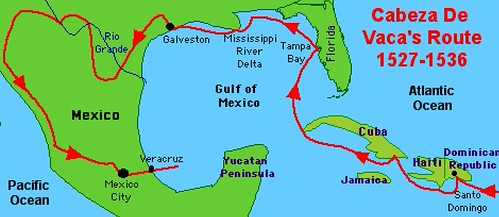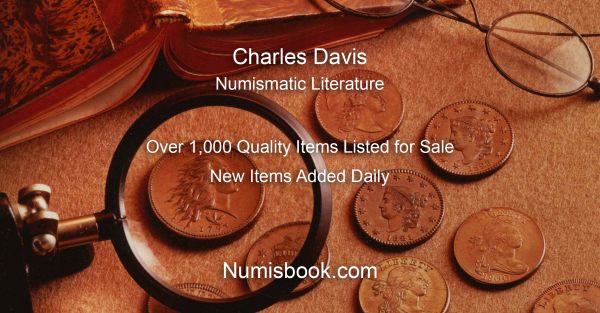
PREV ARTICLE
NEXT ARTICLE
FULL ISSUE
PREV FULL ISSUE
OLD SPANISH TRAIL (1535-1935)E-Sylum Feature Writer and American Numismatic Biographies author Pete Smith submitted this article on the Old Spanish Trail and the Old Spanish Trail commemorative half dollar designed and marketed by L. W. Hoffecker. Thanks! -Editor
Old Spanish Trail (1535-1935)
My research into the story of L. W. Hoffecker got me interested in the Old Spanish Trail. I think that story is also worth telling.
"For once, no venality appears to have been involved, only praise. No scandal attached itself to Hoffecker despite his being a well known coin collector. Collectors did not receive favored-party treatment in distribution of the coins; speculators got none of them." Hoffecker promoted the legislation that authorized the coin. The Act was passed on June 5, 1935. The relevant part of the legislation stated, "That to indicate the interest of the Government of the United States of America in commemorating the four hundredth anniversary of the Expedition of Cabeza de Vaca and the opening of the Old Spanish Trail, there shall be coined by the Director of the Mint silver 50-cent pieces to the number of not more than ten thousand…" Hoffecker designed the coin. The reverse has a map showing the route of de Vaca and passing through the cities of St. Augustine, Jacksonville and Tallahassee in Florida; Mobile, Alabama; New Orleans, Louisiana; Galveston, San Antonio and on to El Paso. Texas. None of those existed in 1535.
* * * * * * *
The Expedition of Cabeza de Vaca
This is a short version of a very long story.
On June 17, 1527, an expedition of five ships left Spain with 600 soldiers and colonists. The leader was Panfilo de Narvaez. Alvar N?nez Cabeza de Vaca was treasurer of the expedition and second in command. The expedition stopped at what is now The Dominican Republic and spent the winter of 1527-28 in Cuba. On April 15, 1828, they landed on Florida, possibly near Tampa Bay. After wandering through the swamps in an unsuccessful quest for gold, they returned to the sea to travel west. Narvaez was lost at sea somewhere between the Mississippi delta and Galveston. Cabeza de Vaca was blown ashore with two ships and eighty men near Galveston Island, Texas. For four years, Cabeza de Vaca lived among the indigenous people and survived by trading with the local tribes. With only four survivors from the original crew, they walked across southern Texas. They crossed into what is now Mexico about seventy-five miles downstream from what would become El Paso. They walked barefoot across northern Mexico and down the Gulf of California. Eventually they made contact with other Spaniards in Mexico City and arranged for transportation back to Spain in 1537. When he returned to Spain, he wrote his memoirs of his travels and of the tribes he met, La Relacion y Comentarios (The Account and Commentaries). This was the first published account of exploration in America. The route of Cabeza de Vaca passed through villages and across rivers known only by their native names. It was not documented as it happened but compiled from memories after Cabeza de Vaca returned to Spain. Current maps are based on the best guesses based on limited sources. Spanish explorer Juan de Onate, born in Mexico, visited the El Paso area in 1598. The city was not incorporated until May 17, 1873.
* * * * * * *
The Other Old Spanish Trail
John C. Fremont, with help from guide Kit Carson, identified the Old Spanish Trail as a 700-mile route from Los Angeles to Santa Fe, in what was then Mexican territory, in his 1844 report for the U. S. Topographical Service. The first use was by Antonio Armijo with 40 men and 200 mules in 1829. It was a challenging route across mountains, deep canyons and the Mojave Desert that could be crossed only during brief periods in the spring and autumn. The route was changed in response to hostilities with the Navaho Indians. By about 1855, now under American control, the pack trail was replaced with an easier wagon trail. It is now known as the Old Spanish National Historic Trail. Several attempts were made to chart a good path to El Paso. The San Antonio – El Paso Road was established about 1849 to service the California Gold Rush. It was not called the Old Spanish Trail.
* * * * * * *
The Old Spanish Trail transcontinental highway
Construction of an auto highway began in 1915, was open by 1923, and eventually ran 2,750 miles between St. Augustine, Florida, to San Diego, California. In recent years it followed U. S. Highway 90 in the east and U. S. Highway 80 in the west. A comparison of the four maps shows that the reverse of the Old Spanish Trail commemorative half dollar has a route that most closely follows the modern highway route rather than the 400-year-old route of Cabeza de Vaca. While L. W. Hoffecker may have managed sales without favoritism or fraud, the coin commemorated an historical narrative that was concocted without facts. Cabeza de Vaca never visited El Paso, he did not travel over land from Florida to Texas, and he did not establish a trail for later travelers.
To read the earlier E-Sylum article, see:
Wayne Homren, Editor The Numismatic Bibliomania Society is a non-profit organization promoting numismatic literature. See our web site at coinbooks.org. To submit items for publication in The E-Sylum, write to the Editor at this address: whomren@gmail.com To subscribe go to: Subscribe All Rights Reserved. NBS Home Page Contact the NBS webmaster 
|




